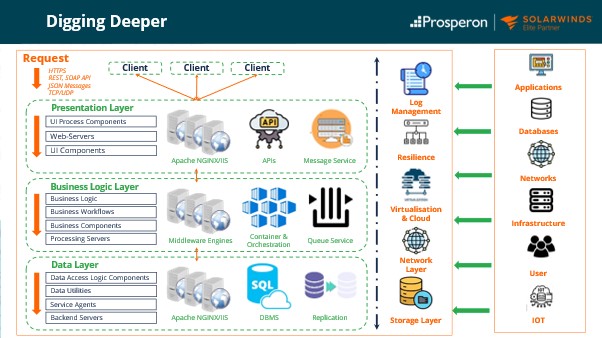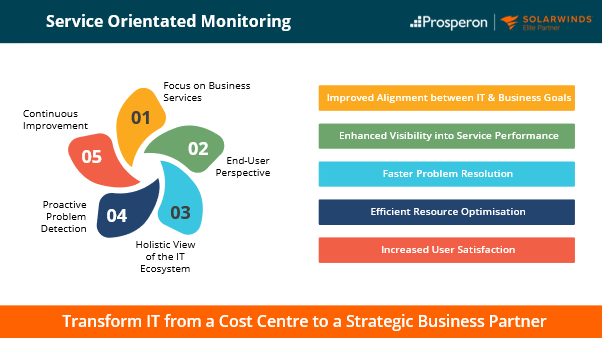A Deep Dive into Service Orientated Monitoring
As promised, the Deep Dive is here! We kicked off in the previous Blog to this series on Exploring the Concept of Service Orientated Monitoring and now, as promised, it’s time for our analysis and thoughts. Hopefully you’ve had some time to have a think about this concept – we’d be glad to talk this through with you on a one-to-one basis specific to your organisational requirements. To guide you through this, find some information below.
There are some key considerations when it comes to implementing SOM and Full Stack Monitoring:
- Data Collection: Implement effective methods to gather relevant performance metrics from all IT infrastructure components.
- Correlation and Analysis: Use advanced analytics to correlate data from different sources and identify patterns and trends.
- Visualisation: Employ clear and intuitive visualizations to present complex data meaningfully, which is technology, role, and service-focused.
- Automation: Set up appropriate automation to alert you of critical issues and enable timely response.
- Integration: Integrate your monitoring tools with other IT management systems for a unified, single-pane-of-glass monitoring approach.

This holistic approach offers many more benefits and significantly speeds up your transition into Service-Oriented Monitoring. We are talking about the works here!
Key Benefits of SOM:
Improved Visibility
- Granular Insights: SOM provides a deep understanding of individual service performance, allowing for more precise troubleshooting and optimisation.
- Dependency Mapping: Organisations can anticipate the impact of changes or failures on other components by identifying service dependencies.
Enhanced Performance
- Bottleneck Identification: SOM helps pinpoint performance bottlenecks within specific services, enabling targeted optimisation efforts.
- Proactive Troubleshooting: By monitoring service health, organisations can proactively address issues before they impact end-users.
Faster Troubleshooting
- Root Cause Analysis: SOM facilitates faster troubleshooting by isolating problems to specific services, reducing the time needed to resolve issues.
- Reduced Mean Time to Repair (MTTR): By identifying issues early, organisations can minimize downtime and improve service availability.
Improved User Experience
- SOM empowers organisations to deliver a more reliable, efficient, and responsive user experience. On both the end-user/customer side as well as those in charge of monitoring these ecosystems.
- By understanding how their systems are performing and identifying areas for improvement, organisations can proactively address issues and ensure that their users have a positive experience.
Approaching SOM. It’s not just about buying the observability solution. There is a bit more to it. You need to be able to:
- Define the Services: Identify the individual services within your business and their dependencies on the technology you use. How do they relate to your business and the other services that your business revolves around?
- Establish Metrics: Determine the key performance indicators (KPIs) for each service, such as response time, error rates, resource utilisation, and more. Identify what is relevant to monitor for each technology, service, or role within your organisation.
- Correlate Data: Analyse data from different sources to understand how services interact and identify potential bottlenecks. Develop a single source of truth that supports your entire business.
That only sounds absolutely wonderful, doesn’t it! But why is this not a standard practice for organisations? That was my next question. I do have some thoughts on the matter, obviously!
- Information technology is rapidly growing, and businesses need so many more integrations with technologies that it becomes extremely difficult to pinpoint what is critical. With new technologies being introduced so frequently, it’s hard to make the cultural shift from a node-focused approach to a service-focused approach.
- It is hard to understand the topology of our business services, which is sometimes multi-technology dependent. There are servers, networks, clouds, tunnels, APIs, containers, etc. The list just keeps going on and on. A node-focused approach was suitable when IT systems were far less complex. You definitely need a service-focused approach to make any sense of this now.
- The complexity of technology means there are more stakeholders in the picture with multiple tools and various approaches to monitoring. Getting stakeholder buy-in is a key challenge to achieving service-orientated monitoring or full-stack observability.

I now am a believer and I truly understand why SOM and Full Stack Observability is a game-changer: You focus on business services, not devices. You focus to predict and prevent issues rather than manage them. Finally you aim to improve the experience of both the monitoring team as well as the end user.
Obviously, the session with Mark helped open my eyes and make me a believer. But over the many conversations I have had with customers, I can also briefly tell you why Prosperon is a strategic partner to many SolarWinds customers across the UK and EMEA.
Implementing SOM effectively requires expertise and a holistic approach. Prosperon can help you:
- Define a Service-Centric Strategy: We work with customers to identify critical services and establish relevant monitoring metrics based on our 20+ years of experience as monitoring experts.
- Unify Your Monitoring Landscape: Break down silos and integrate tools for a single source of truth across your IT environment. Automate your monitoring capabilities to maximise your investment in your tools.

Amal Jacob John
Presales Engineer
Amal is a Presales Engineer at Prosperon. As a Presales Engineer, Amal specialises in helping organisations adopt and leverage solutions to enhance their technology infrastructure. With a strong background in strategic technology consulting, Amal is committed to driving business transformation and building lasting customer relationships.
Demo: SolarWinds Hybrid Cloud Observability
Demo: SolarWinds Hybrid Cloud Observability
Exclusive Event: SolarWinds Discovery Forum
Exclusive Event: SolarWinds Discovery Forum SolarWinds Discovery ForumIn this SolarWinds Discovery Forum, on Tuesday 25th March, you will discover how AI-driven...
Service-Orientated Monitoring – The Essence of Observability
I started my journey into the monitoring and observability space very recently. As one of the newest members of the Observability space, I had a lot to catch up on. I have a...
Hybrid Cloud Observability Enables Consolidated IT Service After Merger
CHALLENGE Prosperon Networks’ client, a global law firm providing insurance, transportation, energy, infrastructure, trade, and commodities services to clients, engaged with...
